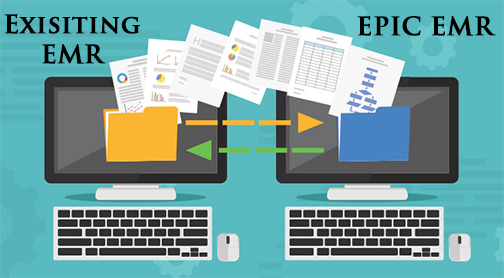22 Jun EPIC Data Migration

Whether you love it or hate it, the EMR mandate is mandatory. An average of 80% of practices have already implemented an EMR or EHR in accordance with the Affordable Care Act’s requirement to convert or pay a non-compliance fee. The other 20% will need to fall in line soon. For those who complied by 2014, the rush to implement an EMR system led practitioners to be swayed by eager vendors and implementation agencies ready to cash in on the opportunity. With over 1,000 options to choose from, physicians, clinics, and hospitals went with platforms that don’t meet updated compliance standards, prove difficult to use effectively, or aren’t adopted across the industry resulting in data sharing obstructions. Thus, there’s a huge calling for the medical industry to move towards a standard platform, ushering in the age of EPIC data migration.
Why Choose Epic?
As the report (linked above) shows, nearly 15% of physicians use EPIC. EPIC is the dominant platform of choice for EMR data migration because it is easy-to-use, widely adopted, and compliant. John Halamka, MD, CIO of Beth Israel Deaconess Medical Center (BIDMC) lays out 5 reasons EPIC became an industry giant:
Reason 1
He writes, “Epic sells software, but more importantly it has perfected a methodology to gain clinician buy in to adopt a single configuration of a single product…Epic’s project methodology establishes the governance, the processes, and the staffing to accomplish what many administrations cannot do on their own.”
Reason 2
Second, Halamka notes that EPIC eases the demand on health information managers and IT staff to support the hospital because EPIC consistently updates and upgrades its product. Therefore, EPIC remains in compliance, bug-free, and progressive with its forward evolution.
Reason 3
Hospitals know if they use EPIC, they will likely always remain in compliance with the ‘meaningful use’ guidelines of the ACA. EPIC has the strongest track record of meeting standards and thus avoiding fees for its clients.
Reason 4
It’s incredibly safe to implement in the initial paper-to-electronic conversion or later migration. No one gets fired by purchasing EPIC. It’s the popular choice in the industry, much like Kleenex is of tissue paper.
Reason 5
EPIC is a deeply integrated system that streamlines data keeping across the spectrum of medical services. EPIC can be shared and used by all specialists, surgeons, and practitioners. This data sharing ultimately allows for greater patient care.
Epic Data Migration
To successfully complete an EPIC data migration, there are three simple steps:
Step 1: Project Assessment
The first step in the EPIC data migration process is the assessment. In this stage, the EMR migrating or converting agency will observe the volume and variation in data entry. Next, the current system and future platform need to be cross referenced. Large variations in data format, preferred fields, financial tracking, and notation exist from the current EMR to EPIC, or one of the other leading systems. The healthcare provider and EMR converting agency need to determine pathways to solve these discrepancies. Lastly, the previous two assessments will determine the quantity or staff needed for the job. Major hospitals will need more EMR migration specialists than a single clinic or physician.
Step 2: EMR Conversion
Stage 2 involves the actual converting. This is the groundwork of the project that calls for filtering patient data records, transferring audio recordings, written notes, and scanned documents. In addition, the EPIC data migration agency needs to identify duplicate or unnecessary data as well as cross-walking data elements such as provider codes, facility codes, pay codes, fee schedules, insurance providers, and insurance plans. If any paper records were left behind from the initial EHR implementation, then this is the time to scan files into the system.
Step 3: Training & Monitoring
The final stage is training & monitoring. The data migration team holds strong expertise in operating, charting, and archiving data and records on the new system. That knowledge and skill is passed on through training of in-house personnel such as physicians, nurse practitioners, RNs, or technicians on how to use EPIC on a daily basis. In addition, physicians can elect to contract to continue a relationship of charting and editing dictations moving forward. The agency, such as KMTS, provides ongoing monitoring and support so that a successful transition ensues.
Next Steps, Epic Data Migration
It is time to move forward with your EMR migration. If you feel comfortable with EPIC, great! If not, KMTS provides data migration service for any platform on the market. Call Kristin at (310) 545-0982 or contact here to discuss your personal needs.



